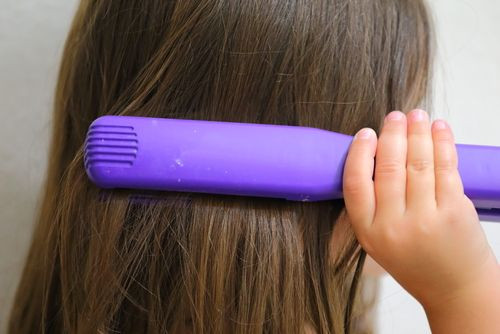Toddlers More Likely To Suffer Burns From Hair Straighteners And Hot Drinks: 4 Burn Safety Tips To Protect Your Child

The scenario of a mother cooking over a hot stove while holding her baby, and talking on the phone, is fairly common in homes. Multitasking is a talent acquired by many moms who work in the office, at home, and take care of their children. However, being this overly ambitious could not only take a physical toll on the parent’s health, but also impact the health of the child. According to a recent study published in the Archives of Diseases in Childhood, hair straighteners and hot mugs, are the leading cause of burns and scalds in toddlers, with one-year-olds at the highest risk.
From washing up under a too-hot faucet to tipping a hot mug, burns and scalds are a potential hazard for adults, and some of the most common childhood accidents. The Centers for Disease Control and Prevention says approximately 9.2 million children annually have had an initial emergency department (ER) visit for an unintentional, nonfatal injury. The nonfatal injury rates were higher among males than females, although these were the same for children under one. Fires or burns, and drowning were highest among children four years and younger.
Babies and young children are especially susceptible to burns and scalds because their skin is sensitive and thinner than adults. A baby’s skin allows more substance through due to fewer elastic fibers which makes it looser, says Discovery Health. The top layer of the skin — the epidermis — doesn’t attach well to the layer below — the dermis — which makes it easier to get through a baby’s skin, unlike adults. In addition, babies tend to have more fat under the skin. This allows for fatty substances, like steroids to easily sink in.
With this in mind, a team of researchers at Cardiff University, decided to examine the characteristics of childhood burns, what are the leading causes, and how it can be prevented. The study examined the burns and scalds of children admitted to five hospital ERs, a burns assessment unit, and three burns units across the U.K. The site, severity, distribution of the burn/scald, age, motor development of the child, agent and mechanism of the injury were all observed in over 1,200 children.
The findings revealed almost three in five of the participants suffered from scalds, while 32 percent had contact burns, and the rest were burns from other causes, such as sunburn. Contact burns in children under five were mostly caused by items such as irons and hair straighteners that were originally left within a child’s reach. The other contact burns resulted from stove tops, and hot baths. The researchers found all of the scald injuries — 709 — had occurred at the home, where hot drinks accounted for more than half of these cases. Tipping of boiling drink down their front usually occurred after the toddlers either pulled down the cup or mug from a table or countertop.
The prevalence of burns and scalds were dramatically lower at three years old. The researchers believes an increased cognitive awareness of the dangers of heat, a more vigilant approach by parents, or a greater amount of time spent outside the home may account for the decrease in these particular nonfatal injuries. "The peak prevalence in infants started at nine months of age, when independent mobility begins, infants are exploring their environment without the awareness of dangers,” wrote the authors, the BBC reports. With the average height of a one-year-old about two feet, six inches, this is the same height as a dining table, or kitchen surfaces that can be within arm’s reach for toddlers.
The study highlights that burns and scalds are far too common in children under five, with the suspectibility to injuries highest when they reach age one. The constant grabbing, pulling, crawling, and reaching things leaves they vulnerable to nonfatal injuries, especially burns. The best invention for this is prevention, which is highly dependent on a parent’s heightened awareness.
To ensure your child is protected from the most common causes of burns and scalds in the home, follow these four burn safety tips:
1) Check The Water Temperature
Parents should make sure the water heater is at a right temperature to prevent accidental scalding. Safe Kids Worldwide recommends to set your water heater to 120 degrees Fahrenheit or the manufacturer's recommended setting. A good rule of thumb is to check the water with your wrist or elbow before proceeding to give your baby a bath.
2) Check The Microwave
While microwaves can provide the easiness and comfort of heating an item within seconds, they can heat unevenly and even create hot spots. Parents are advised to avoid using them to heat up baby formula or baby milk to prevent contact burns in your child. Instead, opt for placing the bottles in warm water, and then let them cool off before you feed it to your baby.
3) Childproof Electrical Outlets and Appliances
At such a young age, toddlers are naturally curious to roam around the house and start pulling on appliance cords in electrical outlets. They may even be inclined to insert metal objects like forks or keys. Covering electrical outlets may be the best way to avoid a child playing with a potentially fatal item.
4) Cool Off Your Hair Straightener
It is important to let your hair straightener cool off, but it’s even more important to make sure they are far from a child’s reach. The Electrical Safety Council in the U.K. launched a nationwide campaign to urge parents to store the devices carefully. Hair straighteners could reach temperatures 428 degrees Fahrenheit and at stay hot for up to 40 minutes after they had been switched off.
Source:
Jones S, Kemp AM, Maguire SA. Patterns of burns and scalds in children. Archives of Disease in Childhood. 2014.



























